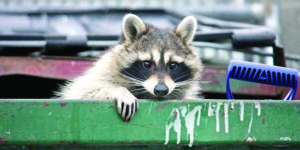By Dr. Beth Leermakers
Raccoons are frequent visitors to my neighbors’ yards (but not mine, thanks to my dogs). While it may be tempting to feed the adorable critters, doing so is likely to keep them coming back for more — and that can cause problems. In February, Carrollton Animal Services warned people to be sure their dogs are vaccinated to protect them from canine distemper, due to a recent increase in distemper cases among raccoons in North Texas, including Carrollton.

Photo courtesy of SOS Wildlife Control
Here are a few fun facts about raccoons, and tips for getting, and keeping, them out of your house and yard.
Raccoons are Well Adapted for Nocturnal
Breaking and Entering
Raccoons “see” with their hands. Like people, raccoons have five nimble fingers on each hand (and five toes on each foot) that allow them to open containers, including trash cans, and manipulate latches, boxes and doorknobs. Raccoons have four to five times more sensory receptors in their paws than most mammals do. These receptors allow raccoons to “see” the world with their hands, distinguishing between objects at night without visually seeing them.
The name “raccoon” came from an Algonquian Indian word arakun, which means “he scratches with his hands.” During the 1700s, American colonists dropped the “a” in arakun, and the name became raccoon.
Procyon lotor is the raccoon’s Latin name, and lotor means “the washerman.” Raccoons use their agile fingers to wash their food before they eat. Even when they’re not near water, they still go through the same motions, moving their front paws around on the food and lifting it up and down. When they are foraging for food in water, raccoons use their paws to gather sensory information. One study found that moistening the skin increased the responsiveness of the sensory nerves on their paws. In the absence of water, the dunking ritual helps them grip their food and bring it to their mouths.
Raccoon masks deflect glare. Raccoons have built-in eye black (black markings under the eyes, like those seen on football players), which absorbs incoming light, reducing glare into their eyes and making it easier for them to see at night.
Raccoons are
Highly Intelligent
Dubbed “trash pandas,” raccoons have neighborhood smarts that make them excellent suburban scavengers. They have a high number of neurons for their brain size, similar to small primates. Raccoons are good problem solvers who can open complex locks. Research suggests they are quick learners and have good memories, so they’re likely to remember who had the tastiest trash.
One study evaluated eight captive raccoons for causal understanding. Researchers showed the raccoons a cylinder, partially filled with water, containing a marshmallow that was too low to reach. The researchers demonstrated dropping small pebbles into the cylinder, causing the water level to rise so the marshmallow was within reach. Two raccoons learned how to drop pebbles to get the treat. A third raccoon got the treat by tipping over the cylinder.
How to Keep Raccoons
Away from Your Yard
Make your yard less attractive to raccoons:
• Secure your trash cans. Try strong bungee cords, or place something heavy on the lid.
• Eliminate food sources. Don’t leave pet food outside (especially at night). Put compost in a closed container, not an open heap. Pick up fallen fruit from your trees.
• Protect your fruit and veggies. Use an electric fence around your garden, or plant plants with prickly vines or thorny branches around them.
• Eliminate water sources. Cover your pool or fishpond at night. Don’t leave pet water bowls outside at night.
• Use scent repellants (such as cider vinegar or predator urine) near food sources and enclosed spaces. Keep in mind that scents may also irritate your pets, so they won’t want to go out into the yard.
• Install motion-activated lights.
• Keep your yard free of debris. Raccoons like to hang out in dark, enclosed spaces (such as a crawl space under your deck, or anywhere with thick brush). Eliminate their hiding places, and raccoons will move on to a neighbor’s yard.
How to Remove Raccoons from Your House or Yard
If you have a raccoon (or entire family) living in your yard, under the deck or in your attic or chimney, the best approach is to encourage them to relocate. Trapping a raccoon is not recommended.
To evict an unwelcome trash panda, put deterrents (light, music and vinegar- or predator-urine-soaked rags) near the den at night. Remove the deterrents in the morning so the raccoon doesn’t get accustomed to them. For more details, visit dfwwildlife.org/raccoons (How to humanely evict a raccoon or mother with kits). This website also has a list of questions to ask when choosing a wildlife removal company, to be sure the company follows humane practices. In most cases, you should be able to get rid of a raccoon without hiring a wildlife removal company.
While raccoons are clever critters with a knack for nocturnal mischief, feeding them can lead to unwanted visits and jeopardize your dog’s health. To deter raccoons, secure trash cans, eliminate food sources and make your yard less inviting. If they’ve already settled in, use humane methods to encourage them to relocate.
